Santo Stefano, Bologna
This article needs additional citations for verification. (August 2014) |
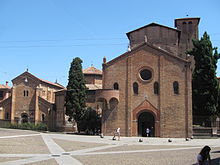
The
History
According to tradition
The different parts of the complex include:
- Church of Saint Stephen or of the Holy Crucifix (8th century, presbytery reshaped in 17th century), with the Crypt
- Church of the Holy Sepulchre (according to tradition: 5th century)
- Church of the Saints Vitale and Agricola(4th century, rebuilt first in the 12th century)
- Courtyard of Pilate ("Santo Giardino", 13th century)
- Church of the Trinity or of the Martyrium (13th century)
- Chapel of the Bandage ("Cappella della Benda") dedicated to the strip of cloth worn around the head by the Virgin Mary as a sign of mourning.
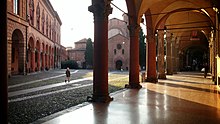
Pilate's Courtyard recalls the lithostrotos, where Jesus was condemned; it leads to the Church of the Holy Sepulchre. In the center, a basin called the "Catino di Pilato", a Lombard work from 737-744, bears the following inscription:
UMILIB(US) VOTA SUSCIPE D(OMI)NE D(OM)N(ORUM) N(OST)R(ORUM) LIUTPRAN(TE) ILPRAN(TE) REGIB(US) ET D(OMI)N(O) BARBATU EPISC(OPO) S(AN)C(TE) HECCL(ESIE) B(O)N(ONIEN)S(I)S. HIC I(N) H(ONOREM) R(ELIGIOSI) SUA PRAECEPTA OBTULERUNT, UNDE HUNC VAS IMPLEATUR IN CENAM D(OMI)NI SALVAT(ORI)S, ET SI QUA MUN(ER)A C(UISQUAM) MINUERIT, D(EU)S REQ(UIRET)
Under the

Church of Saint Stephen or of the Holy Crucifix
The church of the Crucifix is of Lombard origin and dates back to the 8th century: it consists of a single nave with a trussed vault and a raised presbytery on the crypt. In the nave, on the left, there is the 18th century statuary complex of the Compianto sul Cristo morto by Angelo Gabriello Piò [3]. At the center of the presbytery, remodeled in the seventeenth century, which is accessed via a staircase, is the Crucifix, the work of Simone dei Crocifissi dating back to about 1380. On the walls there are 15th century frescoes with the Martyrdom of Saint Stephen.
Under the presbytery there is the crypt divided into five naves with columns of different invoice, one of which, according to legend, from the base to the capital is perfectly equivalent to Jesus (about one meter and seventy, very high for the time); at the end of it, in two urns placed on an altar, the remains of the Saints Vitale and Agricola are kept. On the sides of the altar, a few years ago, two 16th century frescoes were found under a layer of plaster, illustrating the martyrdom of Vitale and Agricola. In the left aisle, at the back near the altar, there is a small fresco of the early fifteenth century, the so-called Madonna della Neve, perhaps of Lippo di Dalmasio. An object of lesser artistic value but of some suggestion is the white statue of the Madonna Bambina, at the beginning of the crypt, on the right wall.
Church of the Holy Sepulchre

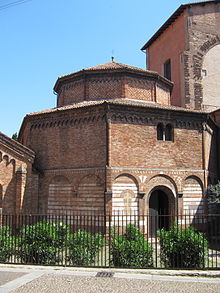
The church dates back to the fifth century, built by the bishop Petronius as a simulacrum of the Constantinian Sepulcher of Jerusalem and rebuilt at the beginning of the eleventh century by Benedictine monks after it was heavily damaged during the devastating 10th century Hungarian invasions. The building, with a central plan, is built on a perimeter with an irregular octagonal base in the center of which a dodecagonal dome is erected. Inside there are 12 columns of marble and brick, while in the center there is a shrine that housed the relics of San Petronio, found here in 1141. The door of the Sepulcher is opened one week a year, after the celebration of mass midnight Easter, in the presence of the Knights of the Holy Sepulcher.
In ancient times it was possible to crawl inside to venerate the remains of the saint; the prostitutes of Bologna, on Easter morning, moreover, in memory of Mary Magdalene, went there to pronounce, before the Holy Sepulcher, a prayer whose content they themselves never wanted to reveal. Still according to another ancient tradition, pregnant women in Bologna used to walk thirty-three times (one for each year of the Savior's life) around the Sepulcher, entering each lap in the tomb to pray; at the end of the thirty-third lap, the women then went to the nearby church of the Martyrium to pray before the fresco of the pregnant Madonna. Today the body of St. Petronius is no longer in this church, after which in the year 2000 Cardinal Giacomo Biffi had it moved to the Basilica of San Petronio, which already guarded the head of the patron saint of the city.
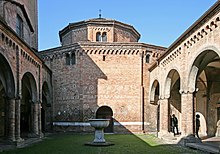
In the church there is also a water source which, in the symbolism of the Stefan complex based on the passion of Christ, is identified with the waters of the Jordan, and which from the archaeological point of view refers to the sacred source of the pre-existing isiac complex. Probably the temple of Isis was in this area, as it seems demonstrated, as well as by the presence of the source (the cult of the Egyptian goddess required the presence of a source of spring water), the persistence of seven Greek marble columns, coming from the city of Karistos (according to surveys made by the University of Geology of Padua), certainly from the Roman period; they have been reused, as you can clearly see, since the seven Roman columns, still standing, were flanked in the Middle Ages by as many brick columns, while where Roman columns were missing, destroyed by the Hungarians raids, new columns were built more robust.
A column of black cipollino marble, of African origin and of the Roman era (also certainly reused from a previous building), offset from the others, symbolizes the column where Christ was scourged and, as stated in a scroll, guaranteed 200 years of indulgence to each and every time you visit this place.
The vault and the walls of the church originally had frescoes with biblical scenes created by Marco Berlinghieri (son of Berlinghiero Berlinghieri) in the mid-thirteenth century, almost entirely eliminated in 1804 to be replaced by new frescoes in Baroque style made by Filippo Pedrini, in turn eliminated by subsequent restorations of the late nineteenth century; what remains of the original thirteenth-century frescoes (a scene representing the Strage of the Innocents) is visible in the basilica museum.
Church of the Saints Vitale and Agricola
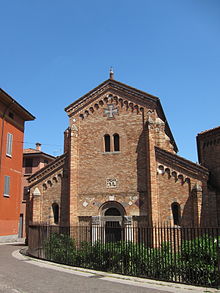
It is the oldest of the complex. This basilica-shaped church, without a transept, with a salient façade and triconca apse, is dedicated to the patron saints Vitale and Agricola and since its construction it housed the relics of the two saints, respectively servant and master, the first two martyrs from Bologna times of Diocletian (305 AD). In 393 the remains are moved from Ambrogio to be taken to Milan (a fact that testifies that the basilica was already built) and also in the fifth century a messenger was sent by Namazio, bishop of Clermont, to have relics of the Bolognese protomartyrs.
At the beginning of the XV century a paleochristian sepulcher with the inscription "Symon" had been found and the rumor had spread that it was the tomb of Simon Peter, that is of Saint Peter. This news, devoid of any historical foundation, had attracted many pilgrims, distracting them from Rome, the classic destination of pilgrimage. The pope, Pope Eugene IV, then reacted vehemently: he made the church open, he had it filled with earth and left it in this state for about seventy years. Subsequently, through the intercession of the archbishop Giuliano Della Rovere, the church was restored and reopened for worship. An inscription on the side door recalls the event: "JUL. CARD. S. P. AD VINC. RESTITUIT". Inside the church there are some interesting finds: remains of Roman mosaic floor, visible through a glass. Then, in the two side apses, two early medieval sarcophagi attributed to Vitale and Agricola, with figures of animals (lions, deer and peacocks) in a raised relief. In the right aisle, on the wall, a cross is identified as that of the torture of St. Agila (in reality it dates back to a later period). The main altar, made up of a turned pagan altar, is set against the back wall (according to the pre-conciliar liturgy, when the celebrant gave his back to the faithful during the celebrations).
Courtyard of Pilate
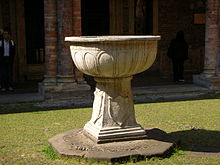
At the Cortile di Pilato, so called to commemorate the lithostrotos, the place where Jesus was condemned, is accessed by exiting the church of the Sepulcher. The courtyard is bordered to the north and south by two porticoes in Romanesque style with characteristic cruciform columns in brick and brings to the center a limestone basin resting on a pedestal (more recent, 16th century) the so-called "Pilato's Cat" : this basin is a Longobard work dating back to 737-744 and bears an inscription under the edge of which is reported the most accredited transcription:
« + UMILIB(US) VOTA SUSCIPE D(OMI)NE D(OM)N(ORUM) N(OST)R(ORUM) LIUTPRAN(TE) ILPRAN(TE) REGIB(US) ET D(OM)N(O) BARBATU EPISC(OPO) S(AN)C(TE) HECCL(ESIE) B(O)N(ONIEN)S(I)S. HIC I(N) H(ONOREM) R(ELIGIOSI) SUA PRAECEPTA OBTULERUNT, UNDE HUNC VAS IMPLEATUR IN CENAM D(OMI)NI SALVAT(ORI)S, ET SI QUA MUN(ER)A C(UISQUAM) MINUERIT, D(EU)S REQ(UIRET) »
Under the portico, in the center of a window, on a column, there is a stone rooster dating back to the fourteenth century, called "Gallo di S. Pietro" to remember the evangelical episode of the denial of Jesus. Always under the portico is It is possible to observe some mortuary tombstones including one, with a pair of real scissors in the center, belonging to a tailor. Significant for the symbolism of the passion of Christ is that the distance between this courtyard and the nearby church of San Giovanni in Monte (so called because it stands on the only natural protuberance of the central dish of Bologna) would be the same that there is in Jerusalem between the Holy Sepulcher and Calvary.
Church of the Trinity or of the Martyrium
Also called the Church of the Holy Cross or of Calvary or Trinity. Originally it had to be built in the form of a basilica with 5 naves, with an apse in front of the holy garden (Pilato's courtyard) and the façade to the east, exactly as it was originally the Holy Sepulcher in Jerusalem wanted by Constantino. Probably due to lack of funds, Petronius could not complete the building that remained unfinished. Later, with the advent of the Lombards, it would become a Baptistery. At the beginning of a thousand, during the reconstructions made by the Benedictines, there were several uncertainties about how to finish the work, considering that the original Holy Sepulcher had been heavily altered and in those years the Fatimite Caliph al-Hakim was working its destruction . So having lost the historical references of what it was originally, the Benedictines could not complete it. After the late nineteenth-century renovations, currently it is divided into 5 naves, with the façade facing the courtyard and the apse facing east, both built in neo-Romanesque style on the model of the Holy Sepulcher built by the Crusaders. From the time of the Crusades and until 1950, a relic of the Holy Cross was kept in the central chapel.
Of great interest, in the last little chapel, entering on the right, there is permanently placed the large wooden group of the Adoration of the Magi, with man-sized statues. It is the oldest known crib in the world made up of statues in the round. [5] A detailed study of the work published in 1981 by Massimo Ferretti, at the end of the first major restoration carried out by Marisa and Otello Caprara, has identified that the sculptor of the statues is the same Master of the Crucifix 1291 kept in the Art Collections of the City of Bologna . The work was first sculpted by trunks of lime and elm, perhaps in the last decade of the thirteenth century by an anonymous Bolognese sculptor. The work remained colorless until 1370, when it was commissioned by the Bolognese painter Simone dei Crocifissi who took care of the rich polychrome and gilding with his very personal Gothic style. The 1981 restoration brought out the splendid polychrome, which had darkened over the centuries, as you can see in the photos before that restoration. But with the subsequent passing of years the humidity of the Church, in which the work was exhibited throughout the year, had begun to ruin the polychrome again. For this reason, at the beginning of 2000 the statues were taken a couple at a time and were restored again, until 2004, when all the work was exhibited in the Pinacoteca di Bologna, where it remained until Christmas 2006, when it was reported to Santo Stefano. Finally, on 21 January 2007 the complete work was inaugurated inside a large electronically controlled humidity and temperature case, equipped with shatterproof glass, which houses the entire group in a permanent and permanent form.
In this church there are also pieces of frescoes from the 14th century, in particular a fragment showing Sant'Orsola with her companions of martyrdom and a pregnant Madonna who, besides being of exquisite workmanship, touches the loving gesture with which she caresses her bursting belly; the other hand of the Virgin holds a book.
The last little chapel on the right has been dedicated, in recent times, to the Bersaglieri, but is devoid of artistic content.
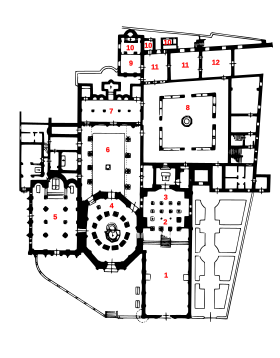
1-3. Church of the Crucifix
2. Crypt
4. Church of the Holy Sepulchre
5. Church of Saints Vitale and Agricola
6. Pilate's courtyard
7. Church of the Trinity or the Martyrium, also called "Santa Croce", containing the ancient Nativity
8. Cloister
9-10-11-12. Chapel of the Bandage ("Cappella della Benda") and museum
Scholarly interest
The focus of scholarly discussion has been for many years the supposed similarity between the so-called "New Jerusalem" rebuilt here, according to a
-
Cloister of the Celestines (Cloister of Santo Stefano Basilica), Bologna, Italy, 1914.
-
The Sette Chiese ("Seven Churches") of Piazza Santo Stefano
-
Calvary Niche in the Church of the Holy Sepulchre
-
Cloister
-
Adoration of the Magi (ca. 1290 - 1370), full-scale sculptures in the Martyrium. Photo by Paolo Monti.
See also
References
- ISBN 9788836530076.
- JSTOR 766940.





